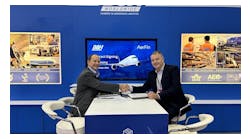One of the most respected guys in the business assesses the MRO scene this way: “Advanced bookings for slots — heavy maintenance slots in particular — is quite solid, right now,” says David Marcontell, vice president of the CAVOK Group, a division of Oliver Wyman. “Supply is limited, and there’s a lot of demand for heavy maintenance activity. A precious few bays are being chased around the globe by a bunch of aircraft. MRO providers “are projecting very full hangars, many of which are pre-sold out for the year.”
That said, Marcontell sounds a cautionary note. “Here’s the challenge: there’s risk out there … multiple indicators of global economic slowdown coming.” If those indicators prove true, he contends, “We could very easily start to see a slackening of that demand and lessening of that rosy, robust outlook.” And if the slowdown happens, it won’t come slowly. “It will hit MRO, specifically airframe MRO, very fast.”
Adding MRO Capacity
So, what’s a growing MRO to do? Many of the ‘Tier One’ players out there are adding capacity right now, or plan to in the near future. Consider:
• Guangzhou Aircraft Maintenance Engineering Company (GAMECO) just opened a new 66,000-square-meter hangar and office space complex. The eight-bay affair, depending on aircraft mix, can accommodate 16 to 18 aircraft, says GAMECO General Manager Norbert Marx. That’s still not enough to meet the expected demand. “We have plans for a massive new hangar here in Guangzhou,” he says, “at Baiyun International Airport.”
• AAR’s Group Vice President for Repair and Engineering, Dany Kleiman, says, “We’re choosing to grow the widebody segment. That’s why we took our Lake Charles, [LA] facility about a year-and-a-half ago and are now working toward completion of a facility in Rockford, IL.” It will be a two-bay affair designed to handle widebodies.
• Construction is expected to begin in 2018 at Atlanta Hartsfield-Jackson International Airport on what president of Delta TechOps MRO Services Jack Arehart calls the “world’s largest engine test cell to accommodate our new aircraft orders.”
Ambitious stuff indeed. Marcontell says CAVOK projects total MRO values (work consisting of airframe, engines, modifications, and components) will post a compound annual growth rate, or CAGR, of 3 percent between 2016 and 2021, increasing from US $67 billion, $687 million to US $78 billion, $312 million.
Projected MRO Growth
In descending order of rapidity, China is projected to grow at 9.4 percent, from US $5 billion, 347 million in 2016 to US $8 billion, $371 million in 2021.
The Middle East is forecast to post 7.0 percent CAGR, going from US $5 billion, $706 million to US $8 billion, $11 million. Africa’s MRO activity is forecast to increase at 6.5 percent CAGR. That means a rise from US $1 billion, $826 million to US $2 billion, $498 million over the next five years. Asia-Pacific is next, with a CAGR of 5.4 percent. In 2016 CAVOK estimates the compound annual growth rate at US $12 billion, $284 million. By 2021 the forecast calls for a value of US $15 billion, $998 million. Interestingly, India is up next, growing at a clip of 5.2 percent, increasing from a comparatively modest 2016 starting point of US $1 billion, $115 million and rising to US $1 billion, $435 million five years down the road. Eastern European MROs’ projected CAGR is 4.1 percent, increasing from US $2 billion, $713 million to US $3 billion, $316 million over the coming five years. Despite the region’s economic woes just now, CAVOK believes Latin America and the Caribbean’s MRO work will grow $3.6 percent, rising from US $3 billion, $455 million to US $4 billion, $120 million.
On the tail end of the growth curve are the comparatively mature North American and Western Europe MROs. Together they start off from the enviable position of commanding the lion’s share of worldwide MRO work values. CAVOK projects minus 0.1 growth in North American MRO work, inching downward from 2016’s US $17 billion, $922 million figure to 2021’s US $17 billion, $822 million total. The slide in Western European growth is projected at minus 0.7 percent, with activity falling from US $17 billion, $718 million to US $16 billion, $741 million.
Marcontell cautions CAVOK’s figures are derived from “a combination of what we’ve seen over the last year,” and “what is pre-booked based upon current plans.”
So, how does an MRO hedge its capacity bets? “You play it very tight,” says the CAVOK executive. “You do not overcommit, and you turn away work when you have to.” He says that’s part of the challenge in running any business. Some opt for the cautious route, others believe “the demand will be there, and I’m going to build that facility — I’m going to take my chances, notwithstanding the thunderclouds that are growing around me.”
Specific Strategies
Depending on the dynamics of their particular market, MROs approach the challenge differently.
“We do a lot of mechanical service in our own network to support our own airline,” says Delta TechOps’ Jack Arehart. “We take the excess capacity and make it available to others in the industry.” The majority of TechOps’ third-party work is powerplants, “about 70 percent,” says Arehart. He’s expecting that third-party work to grow “about 14 percent, year-over-year in 2016 vs. 2015.”
Last year TechOps' overall maintenance operation produced “roughly 3.2-million man-hours,” says Bill Karow, the MRO’s senior business manager for marketing and analytics.
It’s been two years now since Delta Air Lines and Aeromexico opened their 100,000-square-meter MRO plant near Queretaro Intercontinental Airport. Arehart says strategically “we … use that facility for the benefit of Aeromexico, which we own a piece of.” The Mexican flag carrier bills the three-hangar arrangement capable of handling nine aircraft as “the largest aircraft maintenance, repair and overhaul center in Latin America.”
Arehart says so far there’s been minor outside work performed at the Mexican facility. “But by mid-2016 it will be more readily available for third-party inputs.”
AAR’s Dany Kleiman says his company can currently maintain “about 5-million man-hours a year through our facilities.” It’s neither demand, nor hangar space per se that’s the limiting factor, but “the supply of qualified and trained [human] resources.”
To meet the need Kleiman says AAR relies on “strategic relationships” with A&P schools — while at the same time “seeking existing resources in the market by offering a higher value of employment at AAR.”
With a significant share of its customers major legacy U.S. airlines, Kleiman says AAR’s capacity strategy is straightforward. “The majority of our capacity is locked, or negotiated, promised or allocated to our strategic airline partners.”
Of course all the work can’t be locked down. “We can’t secure everything long-term,” concedes AAR’s group VP for repair and engineering. “We will work with the one-off or short-term customers to make sure we can sustain enough footprint, enough capacity [moving] through our hangars.”
AAR is focusing just now on growing its widebody business, thus the Rockford facility mentioned earlier. Not only will it allow AAR to further increase its already expansive North American footprint, but further mitigate the need for customers to send their widebody aircraft overseas. (For more on AAR and LHT's expansions see AMT’s January/February 2015 article, Break Ground for Aviation.)
This trend toward repatriation of widebody work from Asia-Pacific to the carrier’s home continent (or at least home hemisphere) shows scant sign of slowing. In written response to AMT’s questions, Lufthansa Technik said, “Fewer aircraft are being maintained outside their ‘home continent,’ even though ferry flight costs are very low.” That’s why LHT is “increasing its capacities across the globe,” — in the Americas with Lufthansa Technic Puerto Rico and Asia-Pacific with Lufthansa Technik Phillipines. This far-flung MRO capability is one of the reasons LHT manages to generate 6 million man-hours annually.
HAECO Americas (formerly Timco) delivered about 3 million man-hours in 2015, most the result of airframe or modifications. “We expect to see a modest increase in 2016,” says MRO Services President Jim Sokol.
On the growth side, HAECO Americas Line Services network is “increasingly servicing the B787 and expects a similar pattern to follow with the new A350,” says Sokol. To that end, the company is training technicians “to work with new composite materials and advanced avionic systems.”
GAMECO generated approximately 5.1 million man-hours in 2015 via its heavy maintenance, line maintenance, component repair, and engineering efforts. About 3.1 million man-hours were devoted to heavy maintenance.
Like Delta TechOps, a significant slice of GAMECO’s work goes to maintain its “own” airplanes. In this instance that means China Southern, China’s largest airline in terms of fleet size. The carrier is half-owner of the MRO.
GM Norbert Marx appears comparatively unfazed about those “thunderclouds” Dave Marcontell referenced. “We are planning more hangars, and bigger shops,” says Marx. GAMECO is about to open a new landing gear facility, “something you don’t see happening very often these days with environmental requirements.”
Marx sees GAMECO’s biggest challenge as labor rates. “We have to continually improve our efficiencies,” he says, “because labor costs are on the rise … We have to compensate with higher efficiencies. Otherwise we might lose the competitive edge we have.”
Marcontell asserts that while Asia-Pacific labor rates may not have climbed significantly, “They’re still pretty darned high compared to where they were 10 years ago.” He says that tends to offset the advantages of ferry flights propelled by relatively cheap jet fuel.
Cheap jet fuel, bodacious maintenance demand in many regions, and signs that capacity is still king — all provide a modicum of comfort, despite warnings of possible turbulent weather ahead. That’s why David Marcotell’s recommendation to MROs is pretty straightforward: “What they have to do is just execute.”




